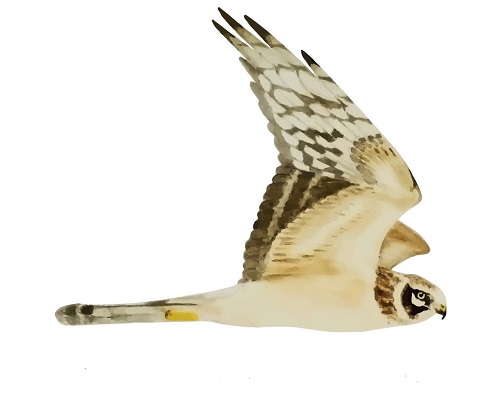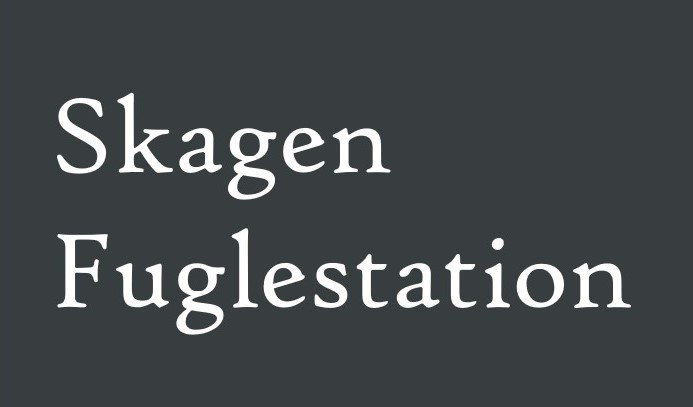Her på Skagen Fuglestations blog bringes korte nyheder i dagbogsformat om hændelser på fuglestationen.
Early Birthday Party
Before it was time to celebrate, we went out – early as always – to follow our passion in the field. The earliest ”birds” of the days were Isis and Hayley, who went to Kabeltromlen for the daily ringing session. Only the early singing Bittern (Rørdrum) made their early start some concurrence. A bit later but still before sunrise, Hannes, Magnus and I passed the ringing area to start our count from World’s End 1.
The ringing was good, even if the numbers were not to high. Two Chiffchaffs (Gransanger) made it feel like summer, while three cute nordic Long-tailed Tits (Nordlig Halemejse) with their snowball-like head reminded of the coldest time of the year. Look how cute they are!
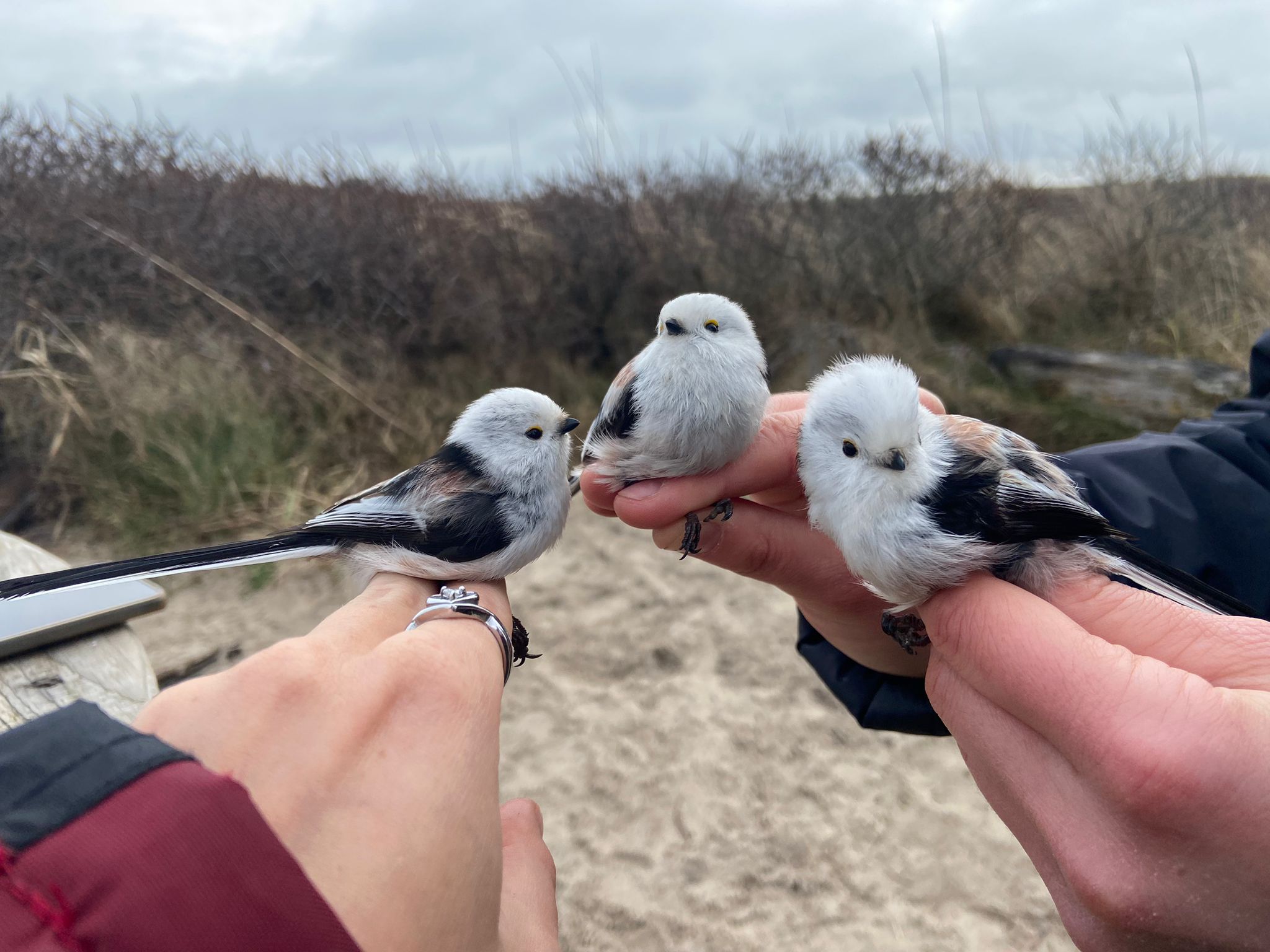
In the meanwhile, the count was pretty slow but we still got good species! Due to Hannes effort we could proof that there were two different Glaucous Gulls (Gråmåge) roosting on the beach. A small flock of Parrot Crossbills (Stor Korsnæb) was also nice. One odd gull landed on the beach. It’s size, body coloration with paler whitish primaries reminded us of a Glaucous Gull, but the face looked weird and the bill was blackish instead of the pink one with a black tip, Glaucous would show. The general impression fitted well for a ”Vicing Gull” – a hybrid between Glaucous and Herring Gull, but the bill pattern is untypical for those. Hopefully someone will find the bird again and take some pictures of it! It’s very obvious, you would not miss this bird!
Since Hannes and I went out with the thermal last night (it was worth it – we saw 3 Jack Snipes (Enkeltbekassin) and 6 Woodcocks (Skovsneppe)) we were all a bit tired, but now, after completing the standardised count, it was time to make a break and eat something.
Then Magnus familiy showed up. His birthday is in five days, but this was the only opportunity for his family to visit him, so they decided to celebrate earlier with a nice brunch. Fortunately, we were all invited. The danish food was super tasty and we had a very nice time with them. We also found out, that ”Hayley does not look like a pig” in reference to the danish pig Yorkshire – the area where Hayley is from. The weather was great, too, so we could sit outside. A really nice break from the hard work.
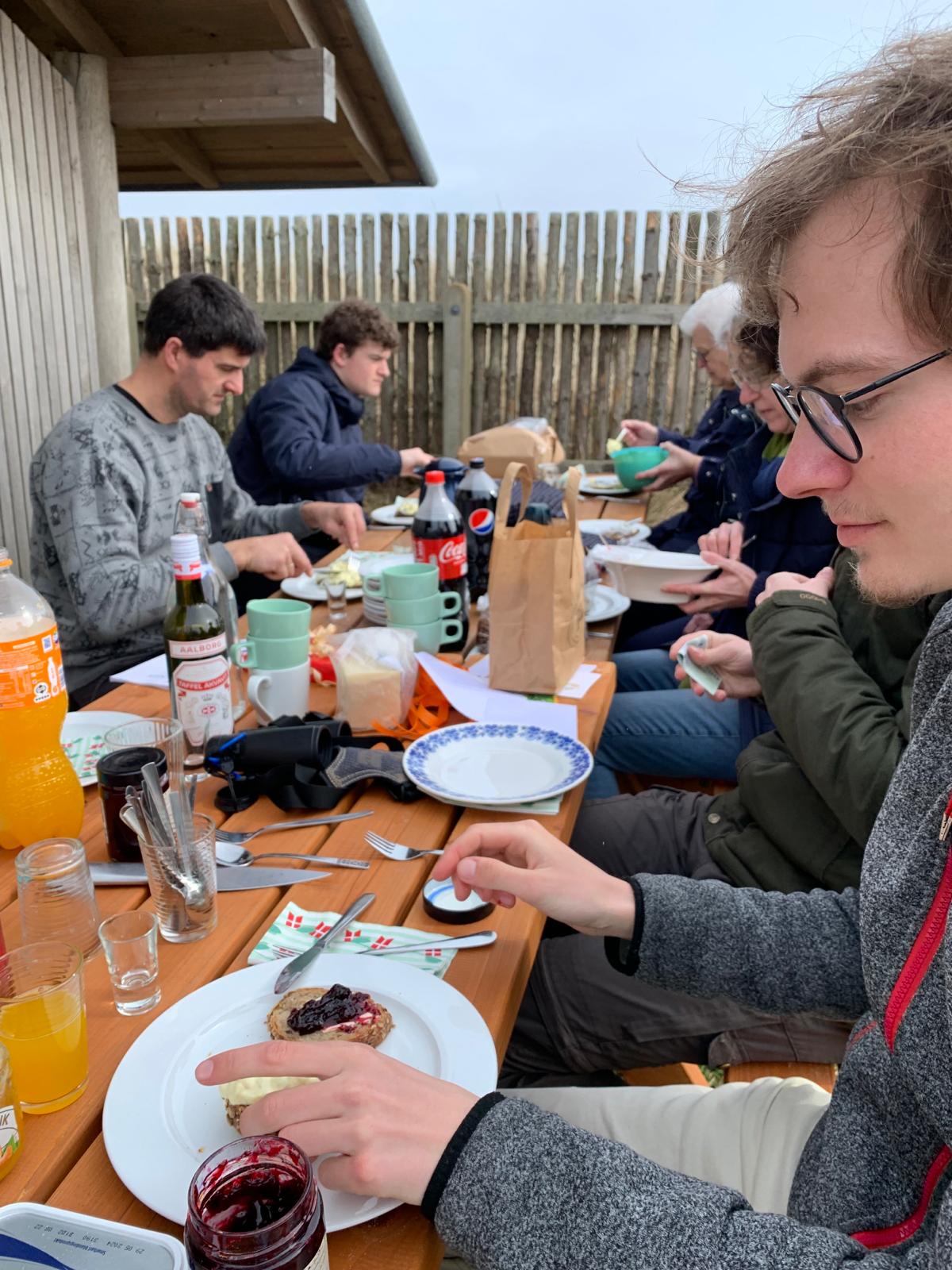
After a short session of data entry Knud came to pick us up and go with us to Skarvsøn to cut some reeds. To keep some parts of the area open does not just help us to count the birds on the lake, but also saves the open areas some wildfowl need. A Bittern (Rørdrum) motivated us with its deep voice and surprisingly a Kingfisher (Ijsfugle) flew by. This species is scarce up here, so it was very appreciated. After around one hour we finished the task.
Ringing (Kabeltromlekrattet):
Total: 30
Ringing (N/V):
| Common Redpoll Nordlig Gråsisken | 16 | RI |
Total: 16
Today’s observations in Dofbasen from observers in the area.
Sum of the raptors in the area based on observations typed into Dofbasen the same day.
People: Hannes Schäfer, Hayley Land, Isis Khalil, Magnus Houen Lauritsen, Simon Kiesé, Knud Pedersen.
More than just Redpolls
Hi there!
Nothing too special today but still some nice variety overall. For me it was time to do the migration-count together with Magnus after we participated in ringing yesterday. That meant a bit more time to sleep than yesterday. The start of the day wasn't hard at all, because we got welcomed by a nice sunrise at Worlds End 1 and pretty nice weather with less wind than expected. On our way there we met Simon, Isis and Hayley at Kabletromlen who were about to go on the first round of ringing for today.
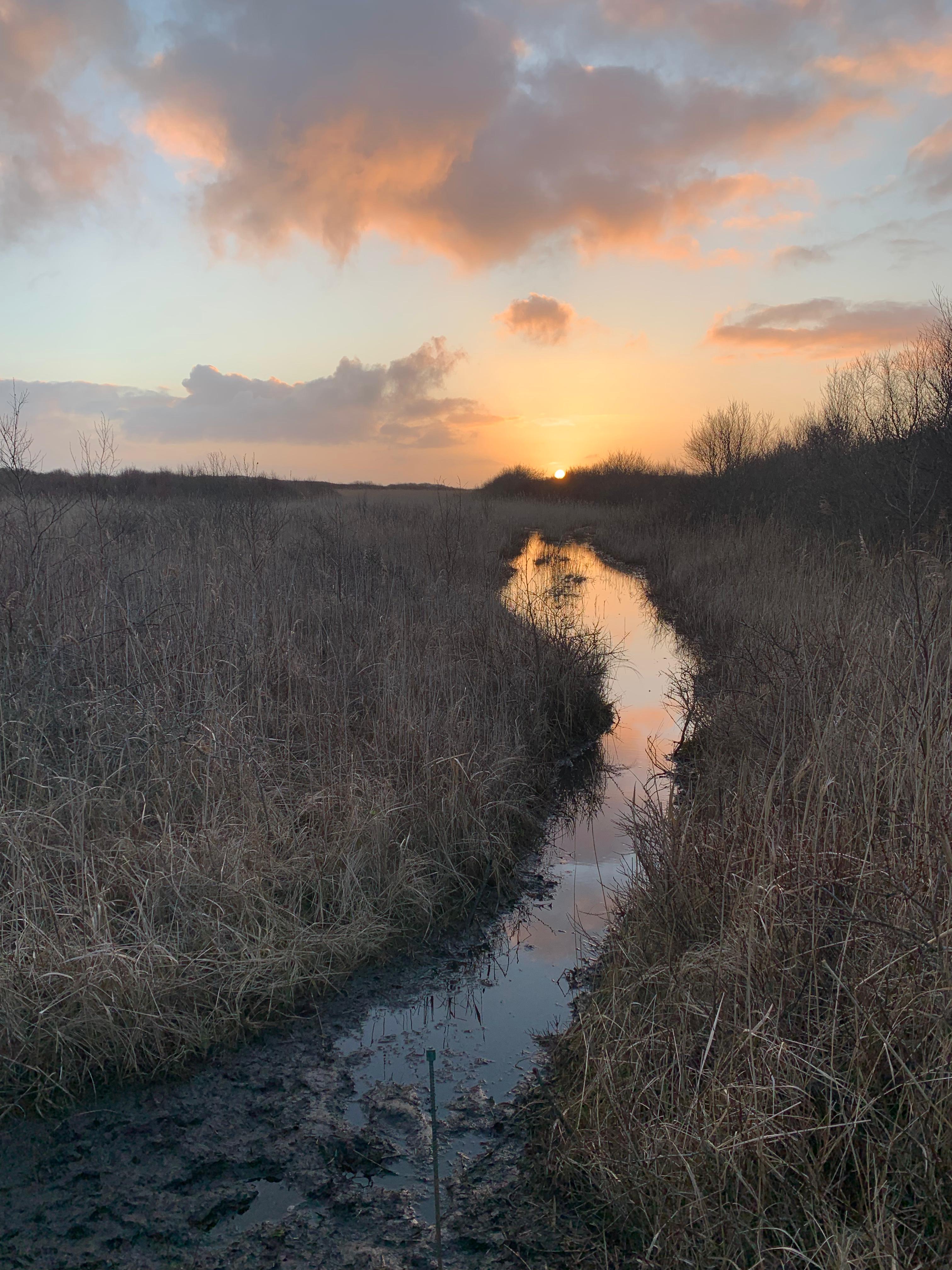
Counting started with some nice variety of birds. We counted 47 different species in the first hour heading north to reach their breeding areas soon. Highlights were 3 flocks of pink-footed geese (Kortnæbbetgås), 4 flocks of Whooper Swans (Sangsvane), 3 Tundra Bean Geese (Tundrasædgås) and around 410 jackdaws (Allike) trying to migrate overseas and giving me some headaches splitting up and going back and forth several times. I also really enjoyed the dunnocks (jernspurv) "jingeling" up in the sky with their nice calls. Unfortunately because of the blue sky the passerines started to migrate really high in the sky, so we weren't able to locate the birds but just heard their calls. The migration of waterfowl got a bit better and we counted 1892 common scoters (sortand) in the last hour of counting. Ringing was nice so Simon told me. He, Isis and Hayley ringed a total of 21 new birds including a reed bunting (rørspurv) and 3 nice bullfinches (dompap).
After ringing and counting we got back to the lighthouse and enjoyed a second breakfast. As the message reached us, a Golden Eagle (Kongeørn) was seen close by to the lighthouse at Elle Krattet heading SW, Simon and I decided to go for a walk and maybe relocate the bird.
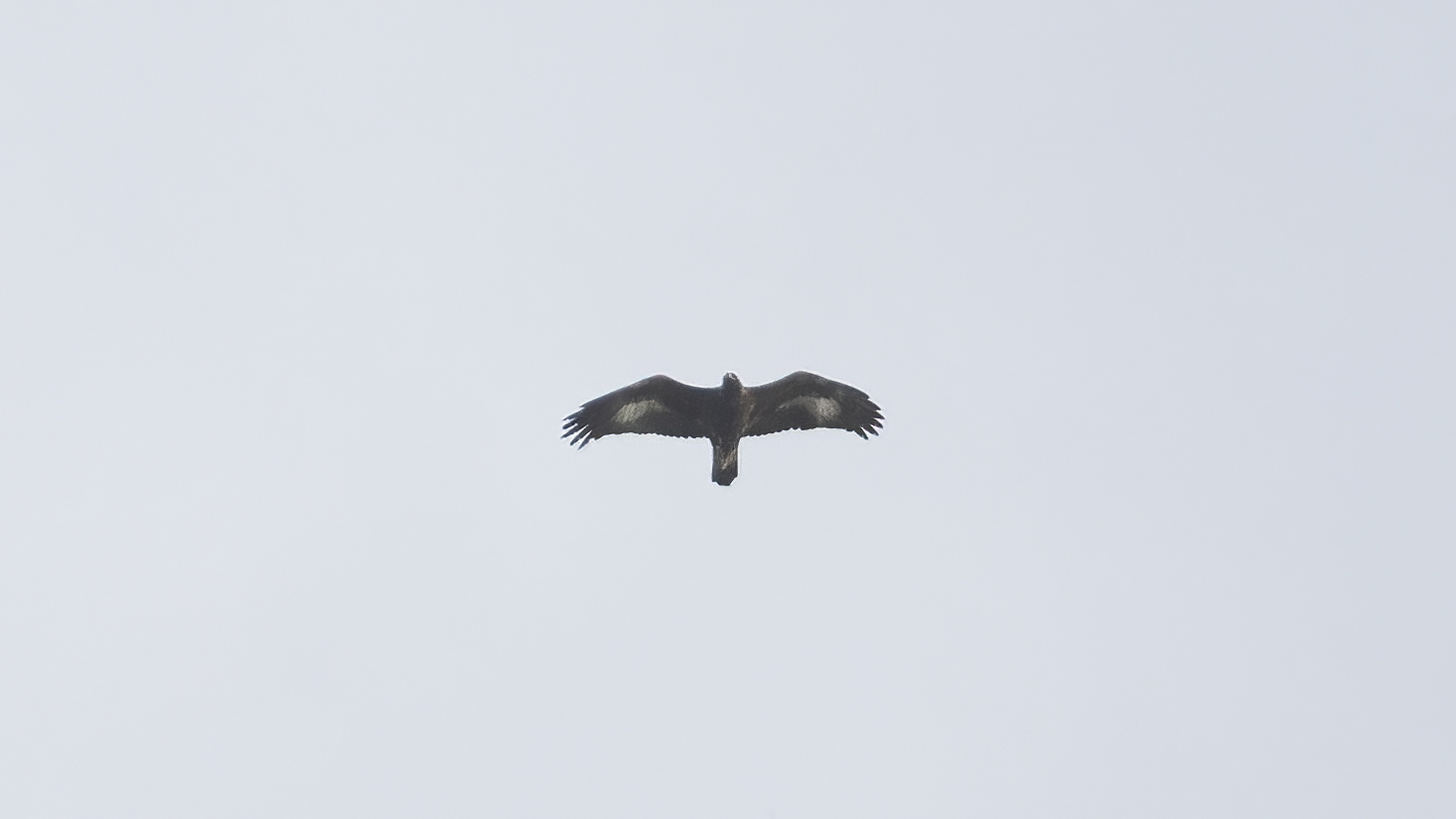 Golden Eagle (Kongeørn) - picture by Knud Pedersen
Golden Eagle (Kongeørn) - picture by Knud Pedersen
Unfortunately we couldn't find it, and only found some common buzzards (Musvåge) and a young white-tailed eagle (Havørn) up in the sky. But the walk was fun anyways because we stumbled over an adder (Hugorm) and common lizard (Skovfirben) enjoying the sun just like us!

After returning we were able to ring 6 mealy redpolls (stor gråsisken) in the lighthouse garden. At first we struggled a bit at ageing them correctly but were lucky to have some birds to compare and could see the differences. That was fun :)
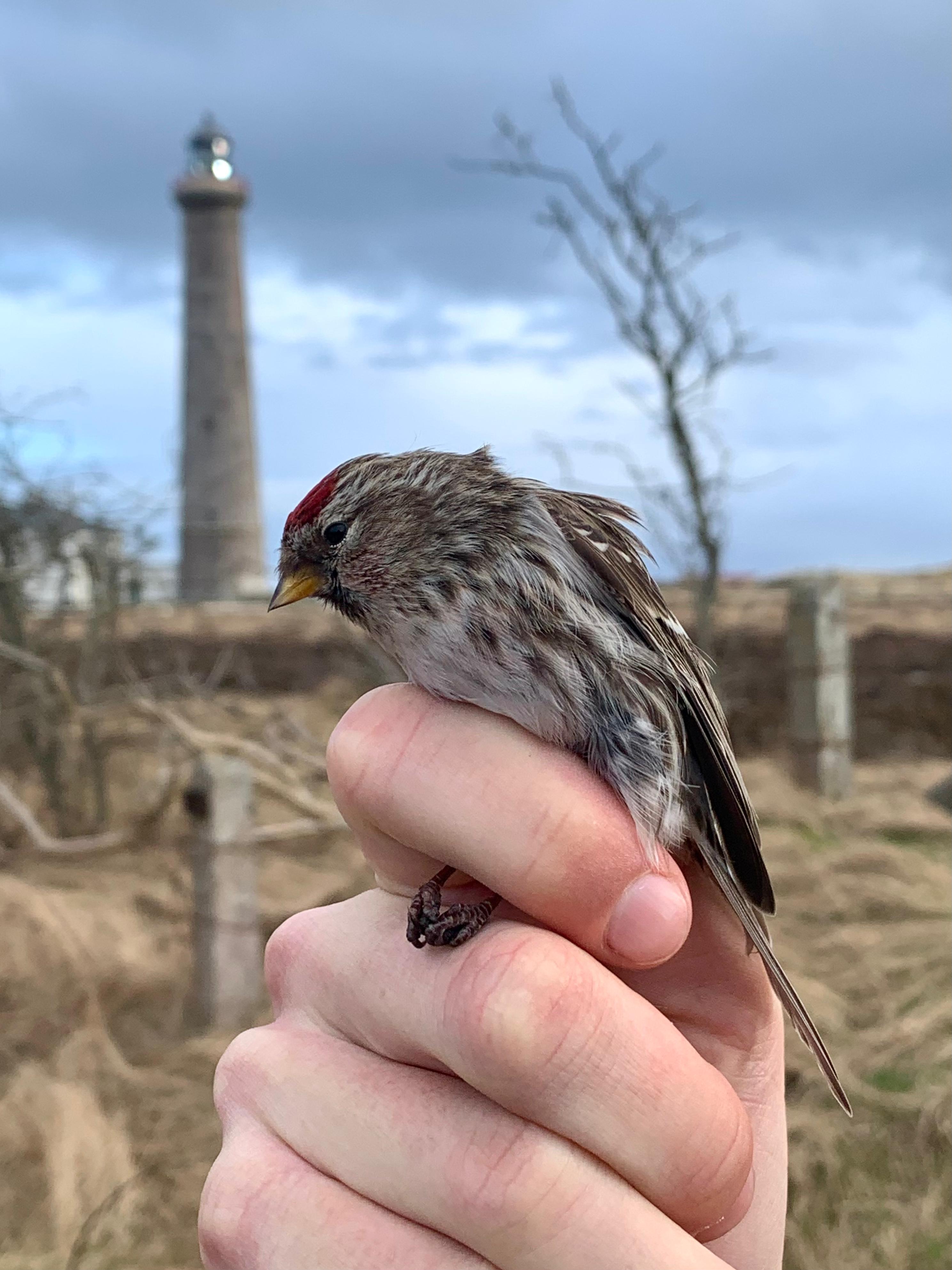
Ringing (Kabeltromlekrattet):
Ringing (Nordstjernevej):
| Robin | Rødhals | 1 | |||||
| Great Tit | Musvit | 1 | |||||
| Common Redpoll | Nordlig Gråsisken | 8 |
Today’s observations in Dofbasen from observers in the area.
Sum of the raptors in the area based on observations typed into Dofbasen the same day.
People: Hannes Schäfer, Hayley Land, Isis Khalil, Magnus Houen Lauritsen, Simon Kiesé.
A New Exhibition and a Hoopoe
It was an early start for my first day back at the station. Magnus, Hannes and I were up well before sunrise to get the nets open at Kabeltromlen and then Simon Sr joined us for the first round. It turned out to be a very quiet morning with only eight new birds ringed in total but it was still so nice to be back!
It was Magnus’ first time at the ringing so there was plenty of time to show him the process and all the measurements that are taken. There was even time to play a game: I’m a migrant! This was a lot of fun and will hopefully help us remember the moult strategy of Blackbirds (Solsort) which is the species we caught the most of today. Whilst we were ringing we also spotted several Sparrowhawks (Spurvehøg) and two Red Kites (Rød Glente).
Meanwhile, Simon Jr and Isis were at World’s End 1 doing the migration count. It was a very quiet morning for them too. Their highlights included a Hawfinch (Kernebider) and large numbers of migrating Chaffinches (Bogfinke). The Glaucous Gull (Gråmåge) was spotted again and they were also very happy to see a Goshawk (Duehøg).
On our way back from Kabeltromlen, we heard over zello that the Hoopoe (Hærfugl) had been spotted again near the car park at Grenen so we went to look for it. Sadly we didn’t manage to see it this time.
Back at the station we enjoyed a very different sort of afternoon. We all attended the opening of the new lighthouse exhibition downstairs. It was so nice to see so many people there.
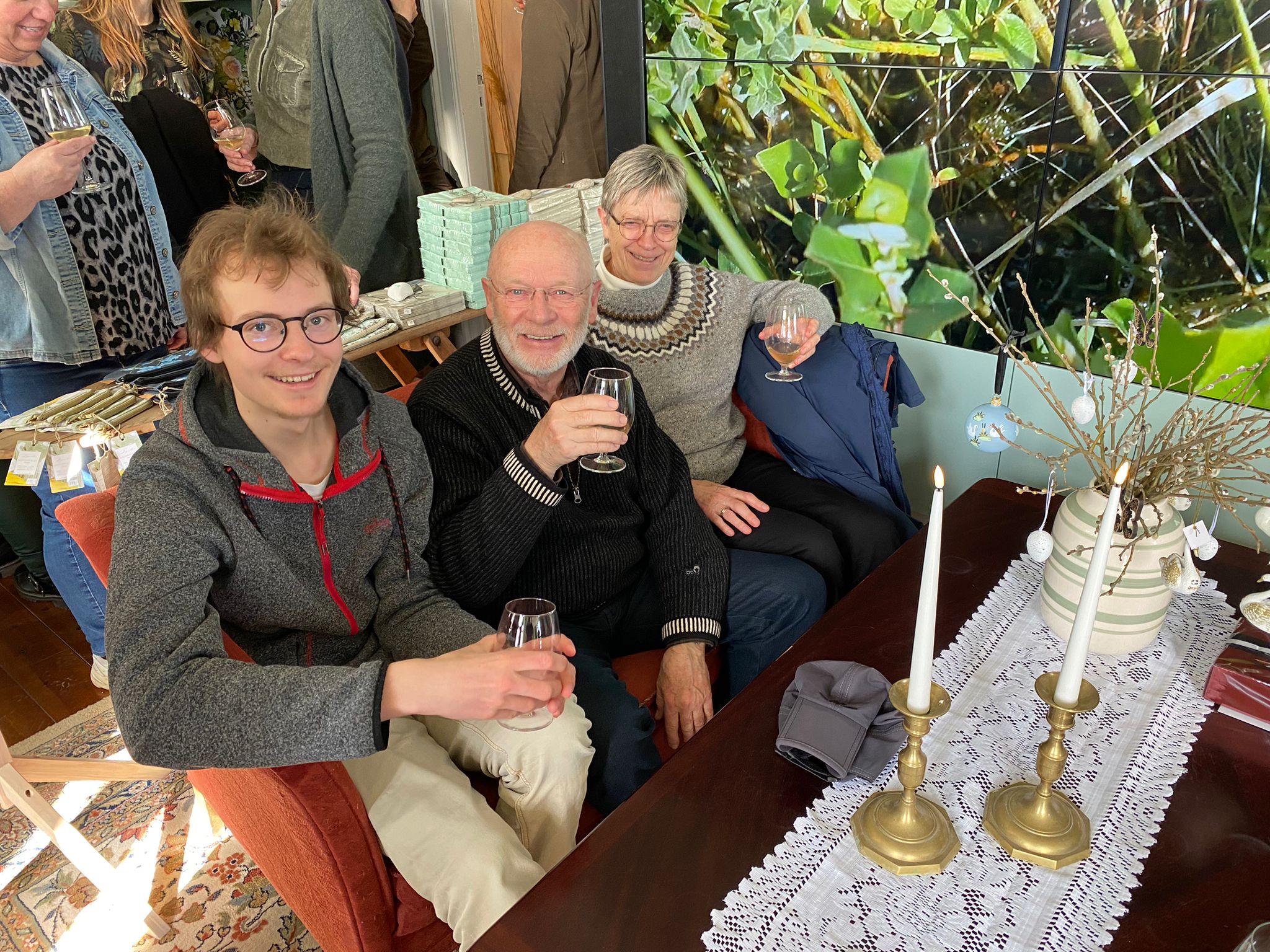
We really enjoyed the cake too!
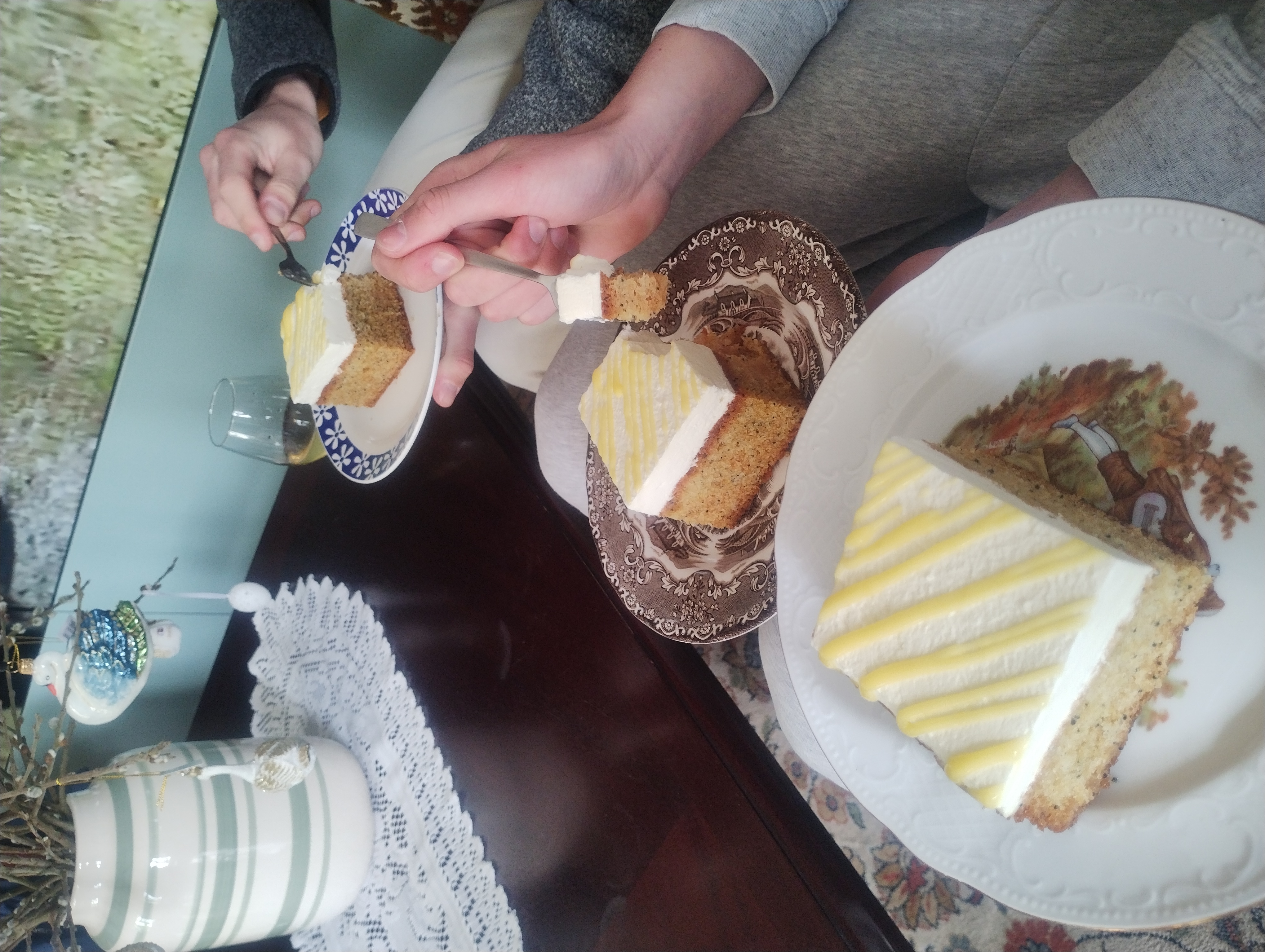
And then we had a lot of fun exploring the exhibition itself.
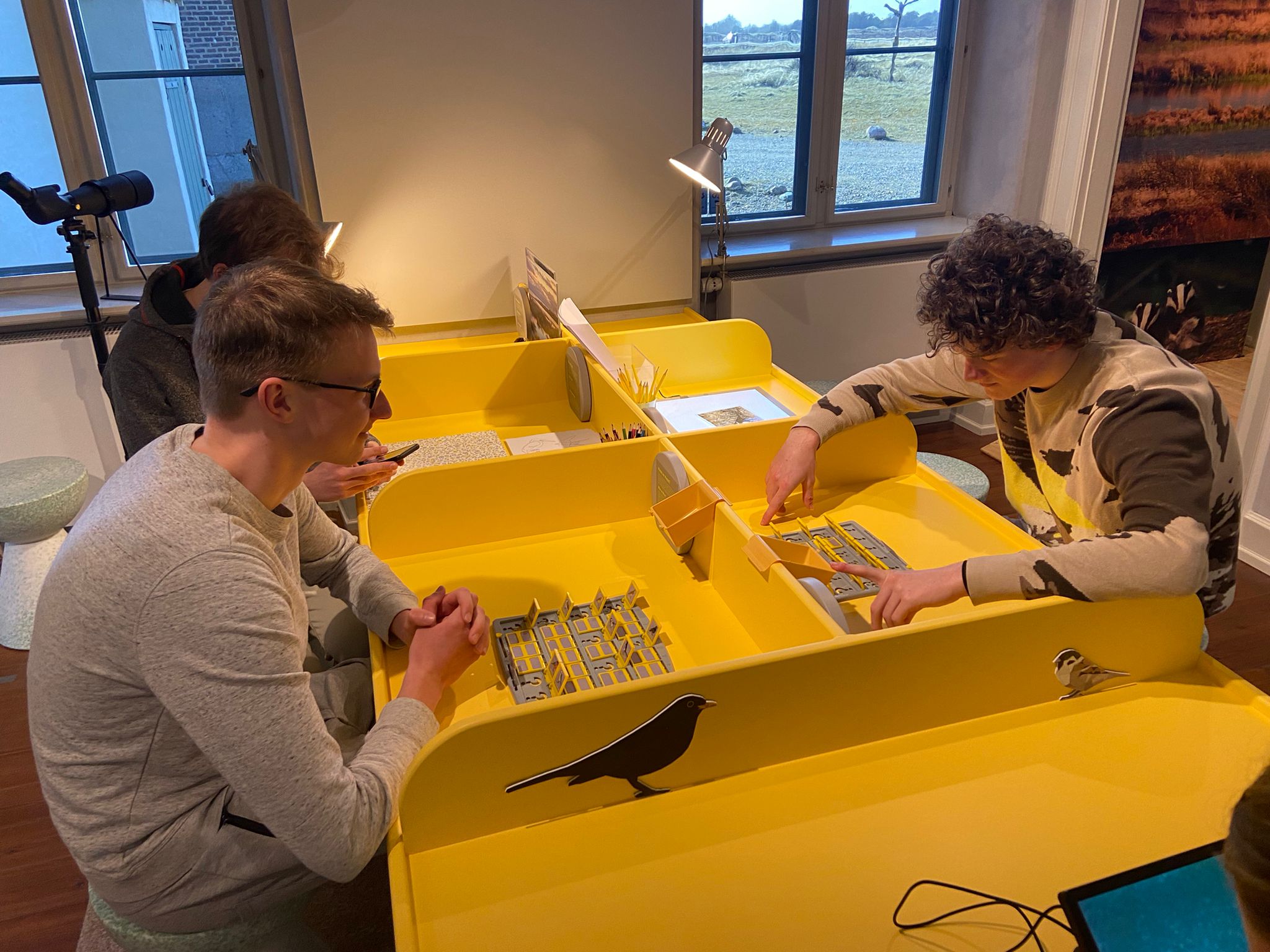
Thank you to the lighthouse team for inviting us!
Later on, Simon and Magnus went shopping and heard that the Hoopoe (Hærfugl) had been spotted yet again, this time to the south of the lighthouse. After returning with the much-needed groceries they headed out again to try and track it down, this time prepared in advance with the hand net. Let’s hope they are successful!
Ringing totals (Kabeltromlen):
Gærdesmutte (Wren) - 1
Solsort (Blackbird) - 1
Rødhals (Robin) - 1
Bogfinke (Chaffinch) - 1
Blåmejse (Blue Tit) - 1
Today’s observations in Dofbasen from observers in the area.
Sum of the raptors in the area based on observations typed into Dofbasen the same day.
People: Simon S. Christiansen, Hannes Schäfer, Hayley Land, Isis Khalil, Magnus Houen Lauritsen, Simon Kiesé
Who Pooed Over There?
Good evening friends! Today has been an interesting day to say the least. Simon and I were up by 04:20 this morning to have all the nets opened and ready before sunrise. There was not so much songbird activity, but enough that we already had our first three birds during the net set up (before the first round)! One of those three first birds was a Redwing [Vindrossel] which I’d been whining all March about, so naturally I was overjoyed when Simon showed me it. I was even allowed to ring it! My first Redwing [Vindrossel]. Needless to say, my day was already perfect before it even started. Aside from that, we had significantly better bird numbers and species today, with three foreign recaptures. Many Eurasian Blue Tits [Blåmejse], one Common Chiffchaff [Gransanger], a few Eurasian Blackbirds [Solsort], some European Robins [Rødhals], two Dunnocks [Jernspurv], and a few more species. We also had a lovely visit from Jørgen and his charming dog Igor while at Kabeltromlen, which was a very welcome surprise.
Simon and I ringing at Kabeltromlen. (Picture by: Simon S. Christiansen)
Dunnock [Jernspurv].
While Simon, Simon, and I were ringing at Kabeltromlen, Magnus and our newest member Hannes were hard at work at World’s End 1. Migration today was decent, the fog was not as bad as yesterday, although it was still quite cold and cloudy. The cloudy weather cleared up in the late morning, and we got some beautiful blue skies and sunshine. Hannes was excited to see the local Glaucous Gull [Gråmåge] this morning. They also saw two Great Egrets [Sølvhejre] today, maybe we’ll get a chance to catch one…
View of the sun from Kabeltromlen in the late morning.
After our busy morning, we all came together and had a lovely lunch at the apartment.
Then…
Who pooed? You pooed? No, no, no.. Hoopoe [Hærfugl]! Thanks to a local birder by the name of Peder Dannow we were informed that there was a Hoopoe [Hærfugl] in the area. Not only was it in the area, but it was in the very parking lot at Grenen, just a couple meters away from the lighthouse! What luck! This might be only around the 40th record in Skagen. In a frenzy of flying coats, binoculars, and scopes, we were out in the field looking for it. We ran into Jørgen and Igor again, as well as several other local birders, and had the pleasure of observing the bird for an extended period of time.
Hoopoe [Hærfugl]. (Picture by: Simon Kiesé)
After seeing the Hoopoe [Hærfugl] we had to rush back to the apartment so that Knud Pedersen could present to us the identification, ageing, and sexing of Harriers. We were joined then by our newest arrival, Haley! Slowly our team is growing again. Like his presentation yesterday, Knud was very captivating and shared many pieces of valuable information to help us distinguish different species, ages, and sexes of migrating raptors. All of this information will prove incredibly helpful in the field during the next few months.
Presentation by Knud Pedersen on Harriers. (Picture by: Simon S. Christiansen)
Finally, we entered data into DOFbasen and onto the Danish Ringmærkningsadministrationen website, planned out the day tomorrow, and updated the daily task board with Big Simon. Magnus prepared a delicious dinner, and we got to have ice cream as dessert thanks to Mette from the Welcome Center downstairs!
Thank you Mette!
Ringing (Kabeltromlekrattet)
Wren (Gærdesmutte) 5
Dunnock (Jernspurv) 2
European Robin (Rødhals) 2
Eurasian Blackbird (Solsort) 8
Redwing (Vindrossel) 1
Eurasian Blackcap (Munk) 1
Common Chiffchaff (Gransanger) 1
Goldcrest (Fuglekonge) 5
Eurasian Blue Tit (Blåmejse) 26
Great Tit (Musvit) 2
Total: 53
Today’s observations in Dofbasen from observers in the area.
Sum of the raptors in the area based on observations typed into Dofbasen the same day.
People: Simon S. Christiansen, Hannes Schäfer, Hayley Land, Isis Khalil, Magnus Houen Lauritsen, Simon Kiesé, Knud Pederson, Jørgen and Igor
Goodbye volunteers and hello ringing season!
The day started an hour earlier than usual. Until now, the observations had been the only data we collected. But today we started another season. It was time for ringing!
Because it was Johannas and Miras last day at the station, they went ringing with Simon Kiesé and SSC, while I counted the migration from Worlds End 1. There wasn’t really that much going on at the nets, and only three different species and 11 birds ended up being caught in total. But much of the time was also spent on correcting the nets and cutting bushes.
Out at Worlds End 1, there wasn’t much going on either. Throughout the whole period, I struggled with fog, which only allowed me to see the horizon once in a while. Despite the fog, i managed to get okay counts of ducks, especially pibeand (Eurasian Wigeon); 625, and krikand (European Teal); 159. Also the glaucous gull turned up to save the day from a total fog-nightmare.
We returned to the lighthouse at about 11.30 to have some lunch, before Mira and Johanna had to pack up their things before returning to Kiel at 15.20. SCC came to pick up the girls, but also Simon Kiesé and I joined the trip to the city, to buy some groceries and snacks, which we definitely needed. We had a bit of an struggle with the pollen during the goodbye, but with the promise of their return in our mind, it all worked out, and we went shopping while SCC was so kind to wait for us in the car. Now we were three volunteers.
After returning to the lighthouse, Knud held a session about identifying, ageing and sexing raptors. Half way through the session Simon Kiesés' friend, Hannes Schäfer, arrived at the lighthouse, and then there were four volunteers. The session was followed up by an evening-meeting, before Simon Kiesé and Hannes Schäfer had the dinner ready, and the day came to an end.
Ringing (Kabeltromlekrattet)
Gærdesmutte: 2
Rødhals: 3
Solsort: 6
Total: 11
Today’s observations in Dofbasen from observers in the area.
Sum of the raptors in the area based on observations typed into Dofbasen the same day.
People: Simon S. Christiansen, Hannes Schäfer, Isis Khalil, Magnus Houen Lauritsen, Simon Kiesé, Knud Pederson, Mira Kieckbusch, Johanna Veentjer.
The raptor season can start now!
Hej allesammen,
today is unfortunately the last full day for us (Mira & Johanna) at the station. So we are trying hard to enjoy every single moment up here before we have to migrate back to Germany to continue at our university.
As most of the mornings, all five of us went out for morning observation, today again from Worlds End 1. On the way there Johanna found another individuum of Klitplasterbille (Apalus bimaculatus) in the dunes at Grenen. Birdwise, there was quite a nice variety of species, with a Merlin (Dværgfalk), Mira spotted, the Glaucous Gull (Gråmåge), probably the individuum we also saw during the last days, one Parrot Crossbill (Stor Korsnæb) and a good number of Teals (Krikand). This is a perfekt example how much variety in birds you get while observing in Skagen. Simon C. also came by to join the morning observation for a while.
After we arrived back at the lighthouse, we had lunch together and entered the data from the morning. Every now and then we make as a team challenges, bets or tastings. Today, it was time for an icecream-tasting, claimed by Simon K. as his 5th breakfast… that was fun!
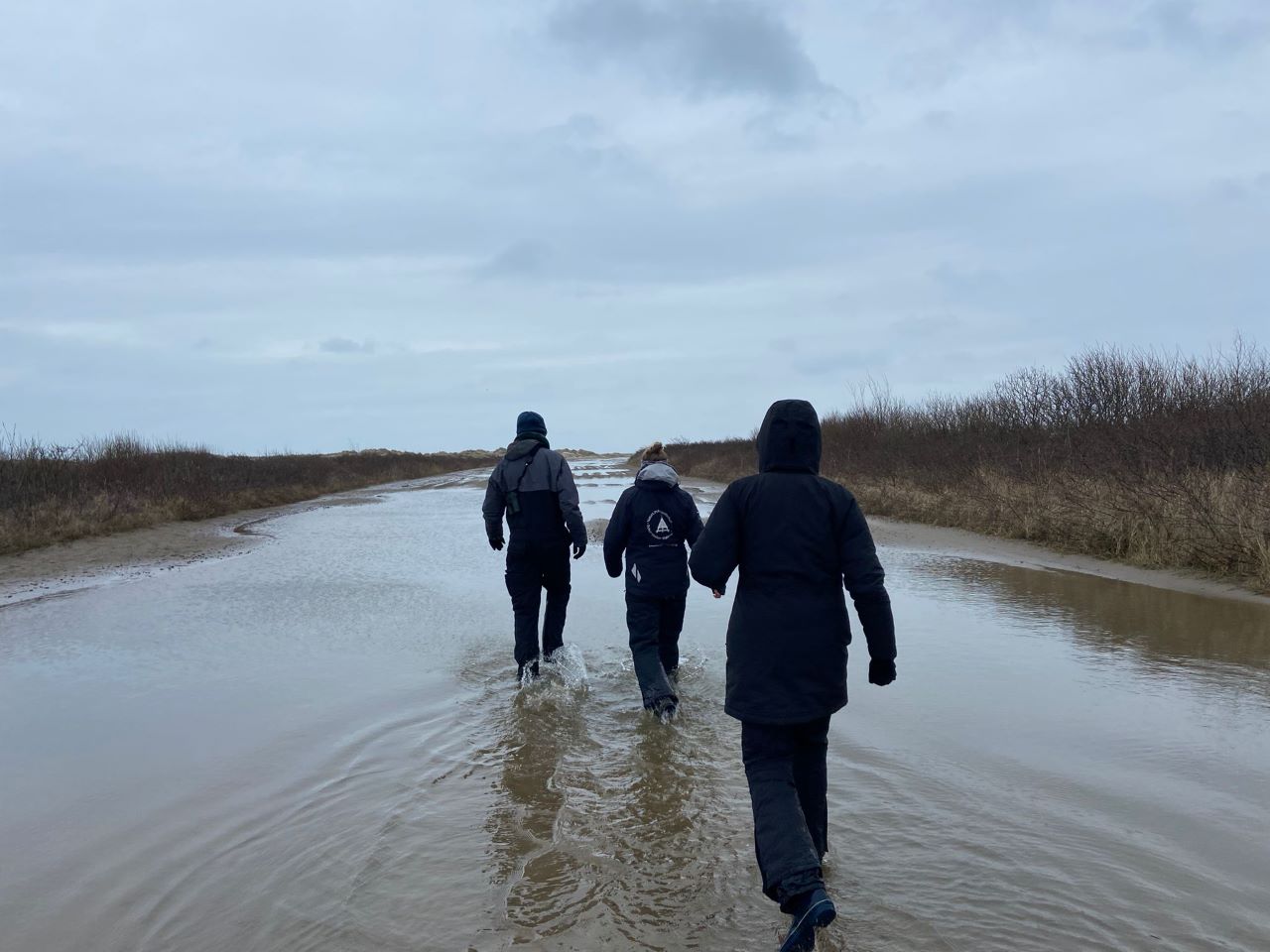
Us on the way to set up the radar.
In the afternoon, a part of us went out to participate in the setup of the Radar for raptor migration observations from Aarhus university. It’s the third year that the radar is set up at Grenen. We managed to help them a bit out while setting the radar up the dune and got the chance to test the special laser binocular.
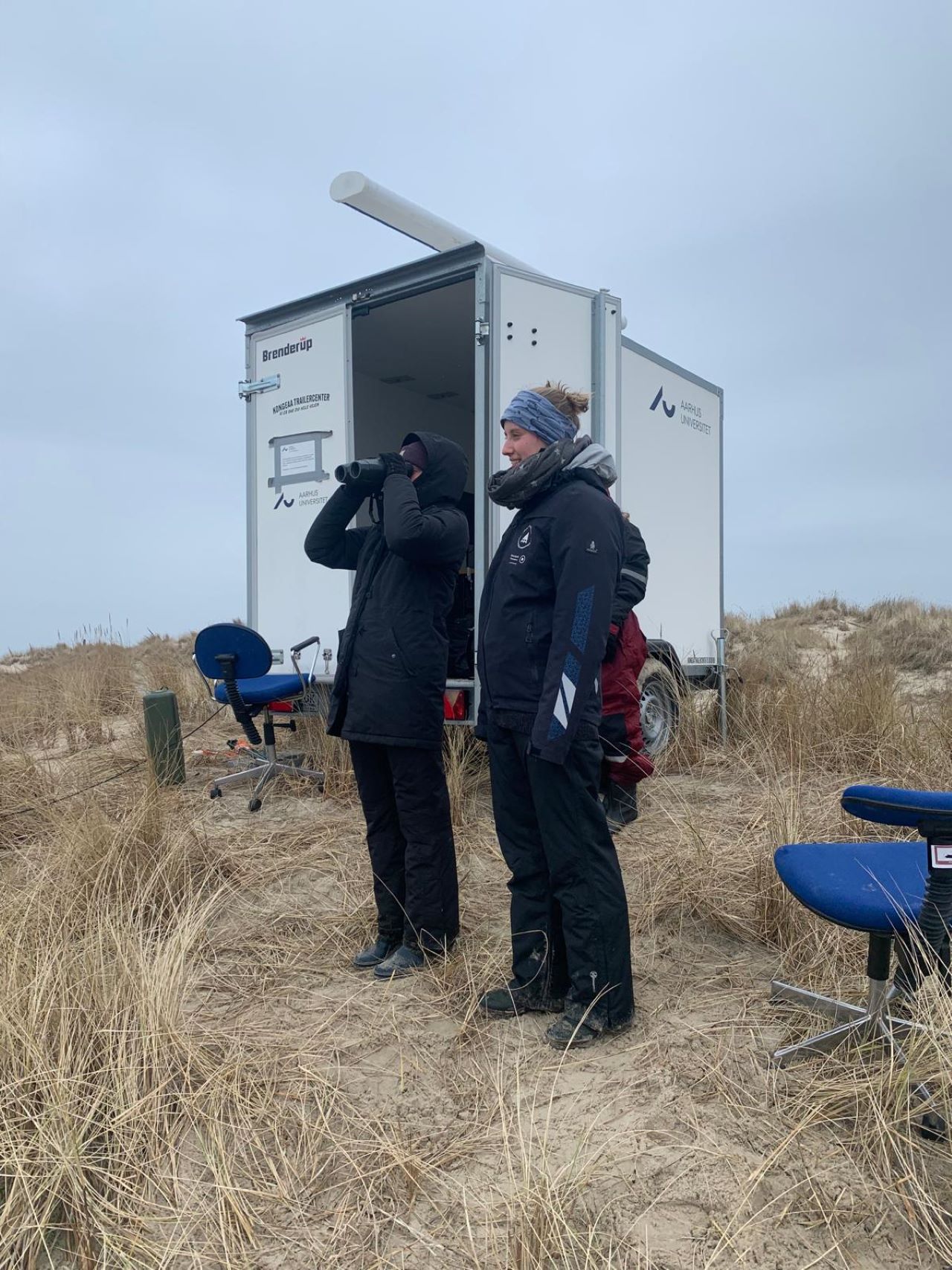
Trying the laser-binoculars.
We also archived interesting news from a Blackcap (Munk) we recaptured last year in october, that was ringed on the 3rd of September in Oost-Vlaanderen, Belgium. It was a first calender-year bird and based on this information we can tell now, how the bird migrated.
Now we will enjoy the last evening for us two at the station and will probably go to bed early, as the ringing season will start now. We really can not wait to go out to open the nets for the first time of the year tomorrow!
At this point we want to say thank you for the last brilliant three weeks we had at the station. Starting our stay with James, also known as “athletic James”, who did not only taught us helpful Papua Neuguinean phrases but also inspired us with his story and humour. Continuing with Isis, Magnus and Simon K. with who we spend almost 24/7 time together, laughing, birding and having great conversations. How amazing is it to meet with like-minded people in Skagen, for us one of the most beautiful places in the world. And of course, a big thanks to Simon C. for having us and making this experience possible! We will definitely migrate up here again someday.
People: Isis Khalil, Magnus Houen Lauritsen, Simon Kiesé, Mira Kieckbusch, Johanna Veentjer, Simon S. Christiansen.
Today’s observations in Dofbasen from observers in the area.
Sum of the Raptors in the area based on observations typed into Dofbasen the same day.
A Redpoll, a Fox and a Halo
Next day – next morning obs at Grenen. After a nice sunrise, it seemed like today will be a strong day with many birds.
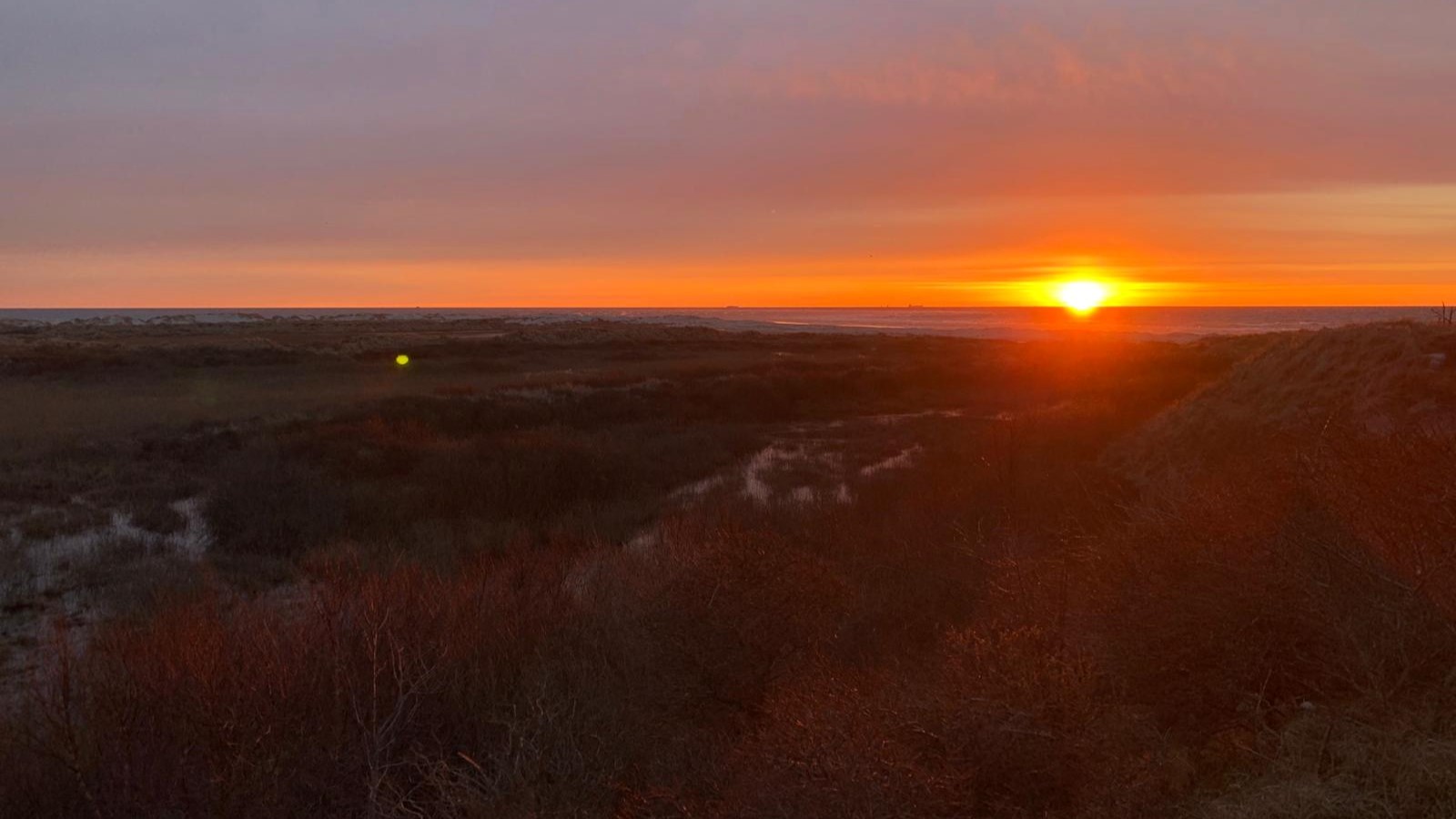
Unfortunately, after some minutes the sun hid behind a layer of clouds and the number of migrating birds normalized. Over the morning there were more than 500 Redpolls (Gråsisken) attempting to migrate. It is really nice to see those again, trying to get back to their breeding range after seeing the big influx in autumn. Since they flew in front of the light sky, it is very hard to see their coloration, but the ones I saw well enough were all Common Redpolls (Stor/Nordlig Gråsisken) - the main species from the influx. It would be interesting to see if there are some Arctic Redpolls in between (Hvidsiken), maybe the results in the ringing will show soon.
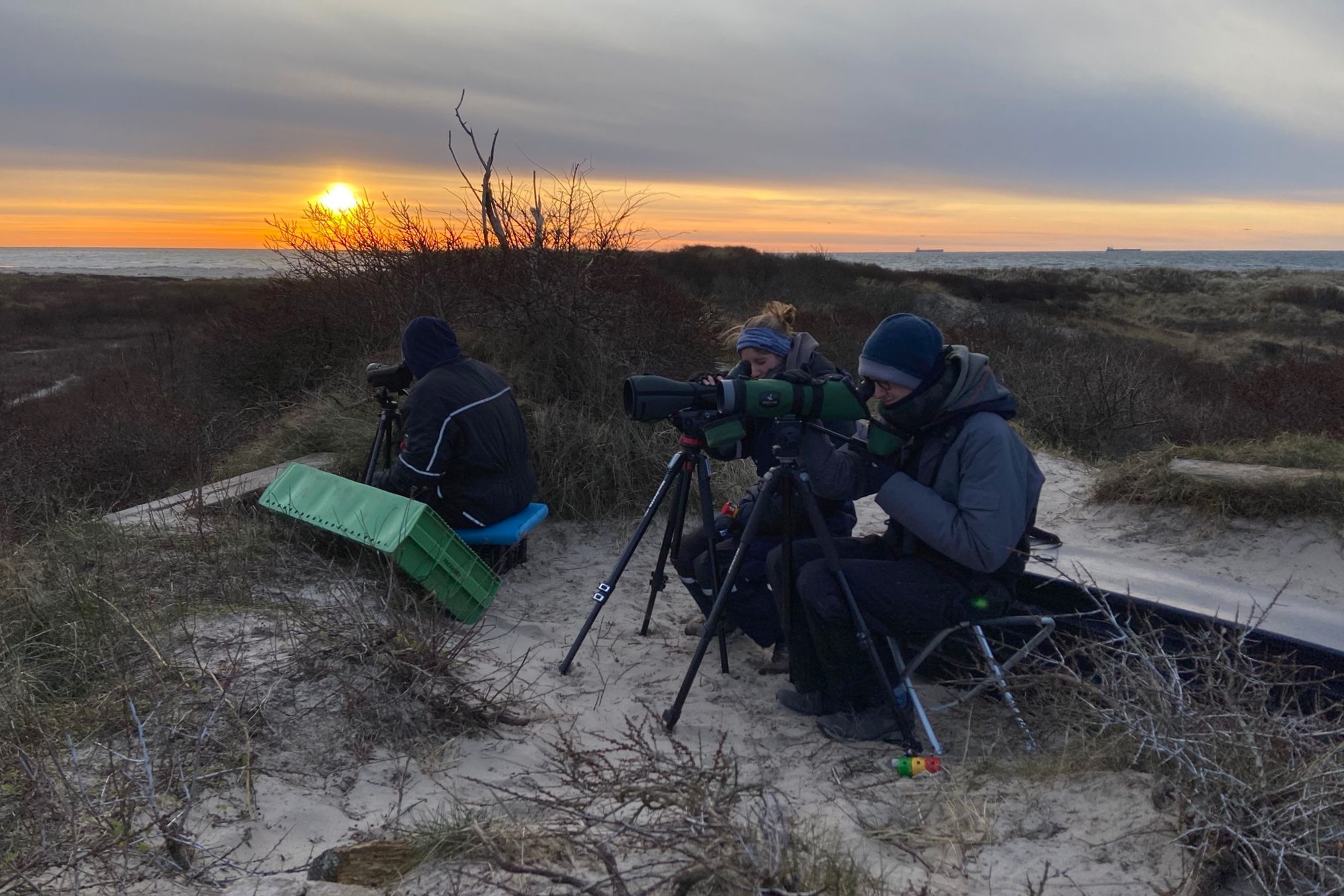
A young White-tailed Eagle (Havørn) did not hesistate to leave Denmark and head towards Sweden. One fox walked along the path, but only Isis was lucky enough to get a view on the nice mammal. The highlight of the first hour was a Shag (Topskarv) heading northwest. With their smaller size, the thin neck and the rounded wings they look very different from Cormorant (Skarv) if you get a good view on them. A nice halo surrounded the sun.
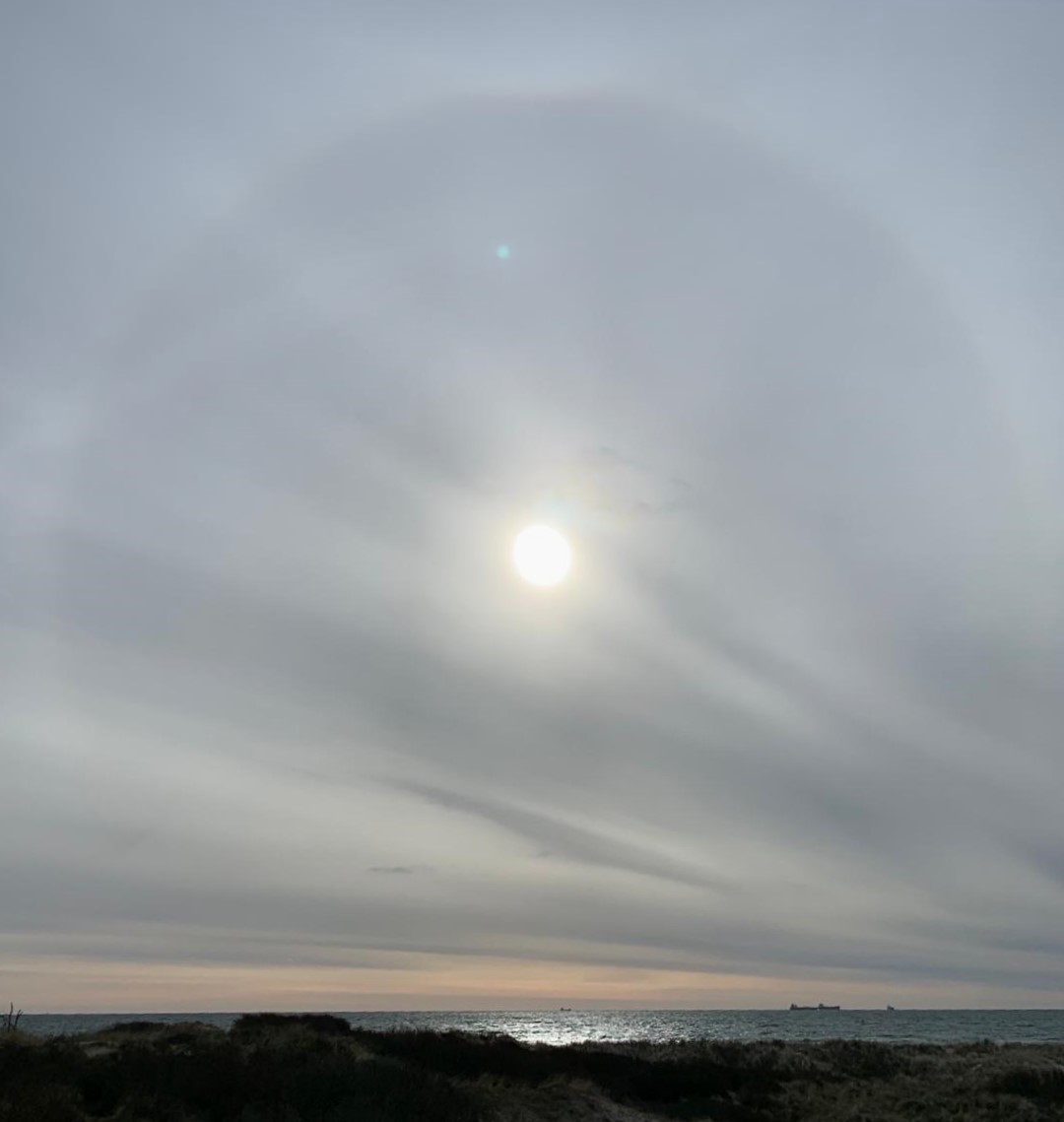
After three hours in the coldness, Mira, Isis and I were relieved by Johanna and Magnus. They brought some cake, which was a super nice breakfast and reward for counting so concentrated. In the next hour, migration went a bit better again and the local young Glaucous Gull (Gråmåge) showed up very close again.
In the meanwhile, us three count-starters had a breakfast and a nice nap. The afternoon was – like always – super productive and we did a lot of stuff like checking the new nets at KAB, setting up the tent for ringing or entering the data. Simon Sr. is back and there were thousand points to talk about. In conclusion, we look very forward to start the ringing season the day after tomorrow!
People: Isis Khalil, Magnus Houen Lauritsen, Simon Kiesé, Mira Kieckbusch, Johanna Veentjer, Simon S. Christiansen.
Today’s observations in Dofbasen from observers in the area.
Sum of the Raptors in the area based on observations typed into Dofbasen the same day.
Topskarver, Klitplasterbiller og mere
Today started bright, you can really feel that the days are getting longer now. So we went out to do the morning observations. There could have been some more migration, but still it was very nice to enjoy the morninghours from Worlds End 1. The highlight of the morning was a flog of three Shags (Topskarv), flying together with one Cormorant (Skarv). This flog was also very nice to observe! In total we saw six Shags (Topskarv) this morning.
And there was another highlight this morning - Magnus found an Klitplasterbille in the Dunes near Worlds End 1 again! Some of us birders went to see it afterwards, where we even found two more indiviuals. The Klitplasterbille has been seen for the last time in 2020 in Danmark, until Magnus and I saw it in the dunes near Nordstrand some days ago.
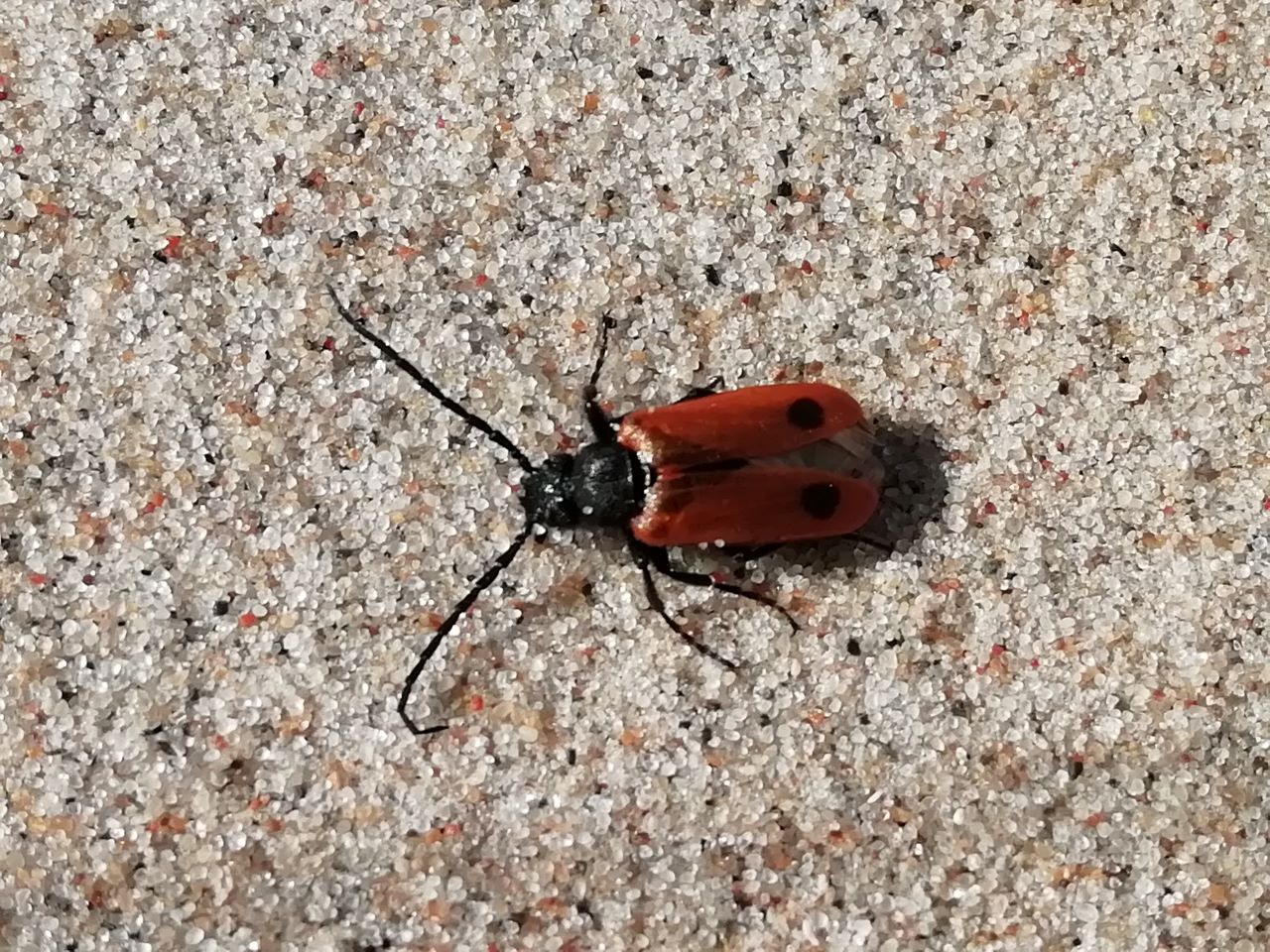
Klitplasterbille (Apalus bimaculatus), found in the dunes near Worlds End 1 today
In the meantime Simon and Isis headed to Skarvsøen, to finish the Novana-Count there. On their way they spotted an adder (Hugorm), you can see in the picture below.
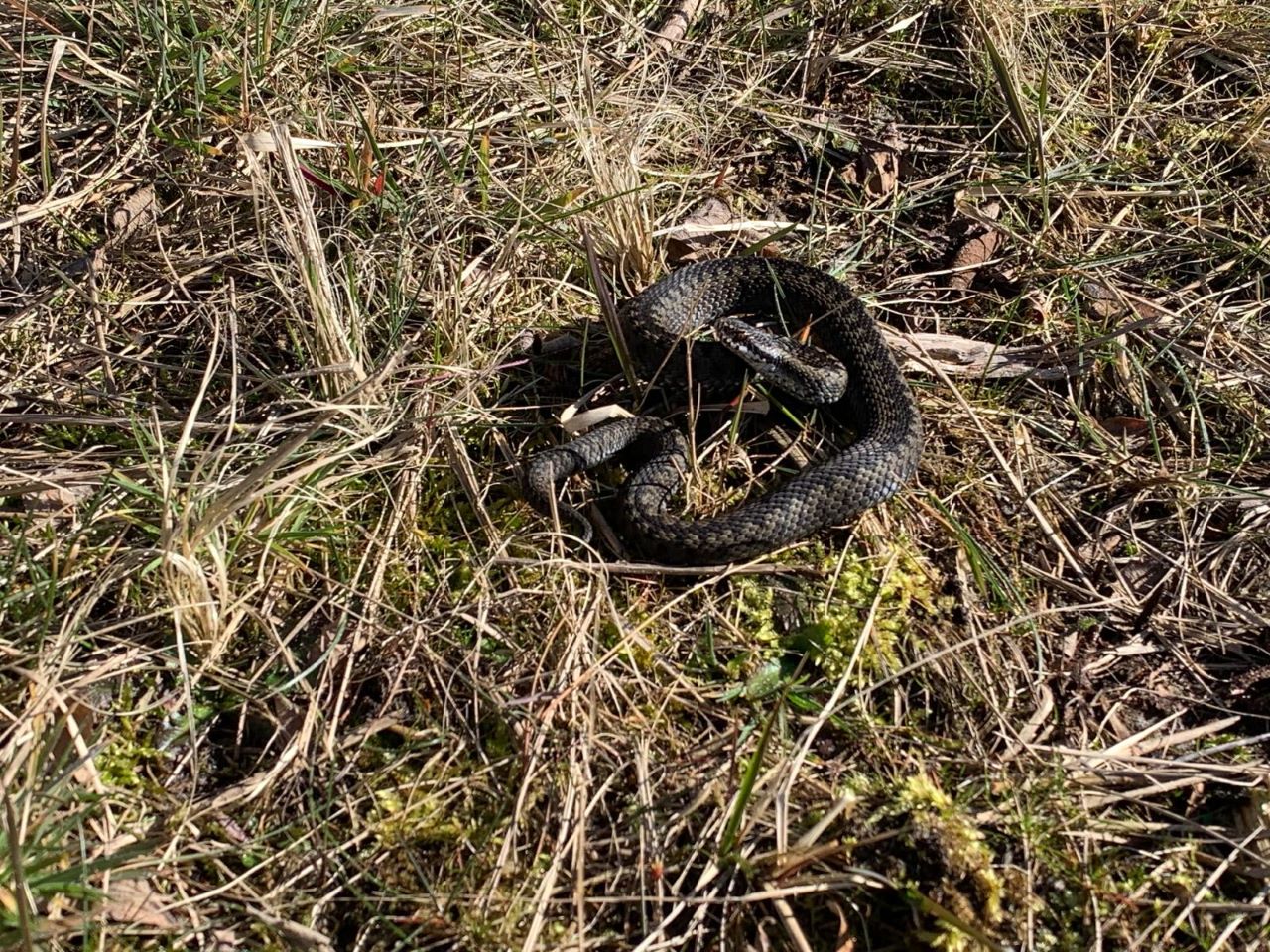
In the afternoon we were happy to have Magnus grandma with a friend as guests at the station. We all had a lovely "kaffe og kage" together.
Afterwards we went out to enjoy the sunny wheater. Some of us went around Grenen and some of us took the bikes towards town. There we were actually able to spot (at least for us) the first Skovfirben of the year, soaking in the last sun rays of the day at a wall.
When all of us met at the station in the evening, we had a nice dinner together. What a beautiful day!
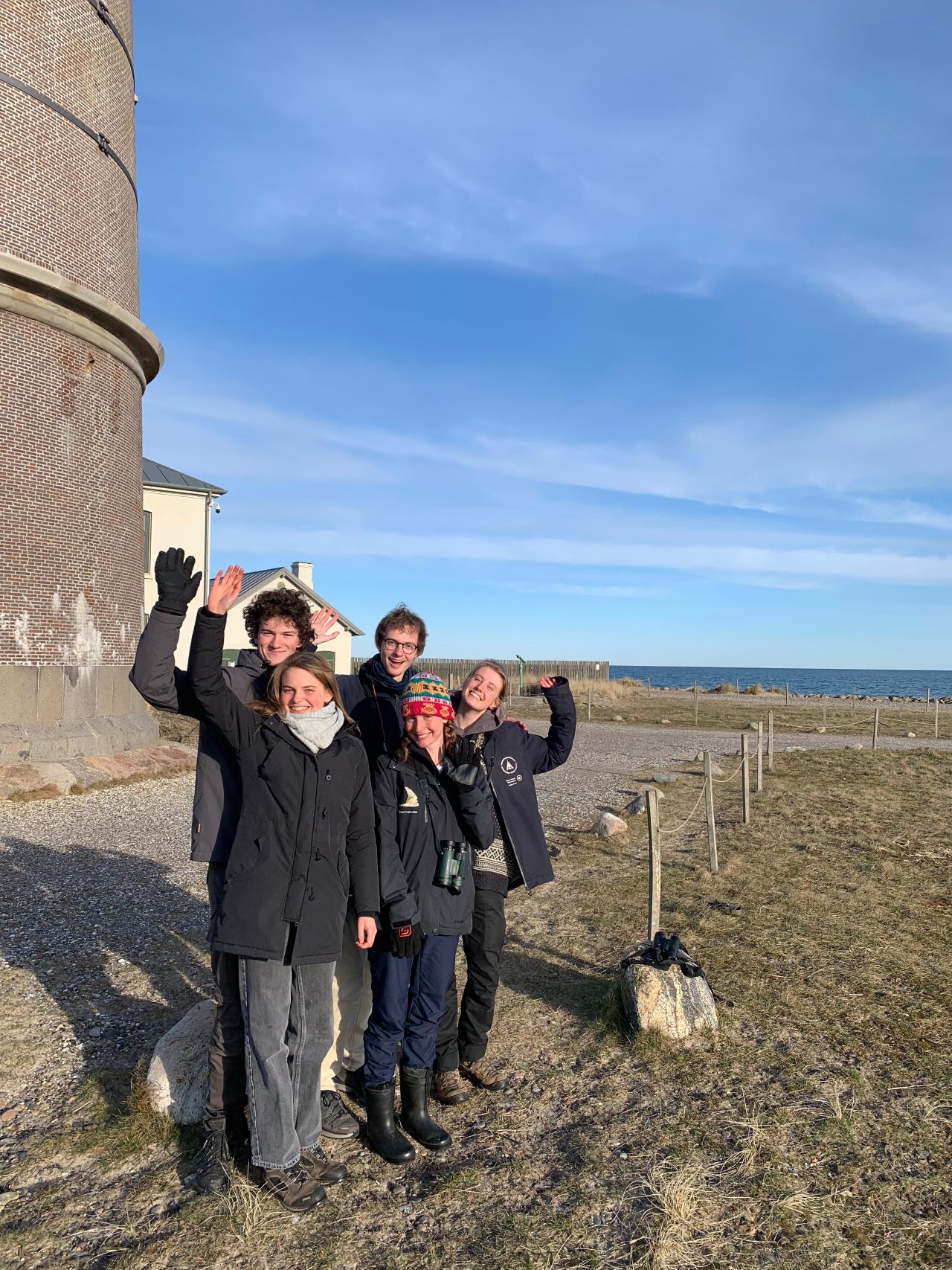
People: Isis Khalil, Magnus Houen Lauritsen, Simon Kiesé, Mira Kieckbusch, Johanna Veentjer
Today’s observations in Dofbasen from observers in the area
Sum of the Raptors in the area based on observations typed into Dofbasen the same day
The winter is back
After the “warmer” temperatures with spring feelings in the last days, the winter reminded us today that he hasn’t left yet. Cold wind from north-west with rain and some snowflakes led to the fact, that we spent the most of the day in the warm and cozy apartment.
Nevertheless, a part of the team went out for the observing from World’s End 1 in the morning. It was a very slow morning, but they saw the second calender-year Glaucous Gull (Gråmåge), that is stationary at Grenen in the last days. Even though the songbird migration was slower due to the weather, the Guillemots (Lomvie) and Razorbill (Alk) seem to like this weather more, than the mist in the last days and migrated in higher numbers.
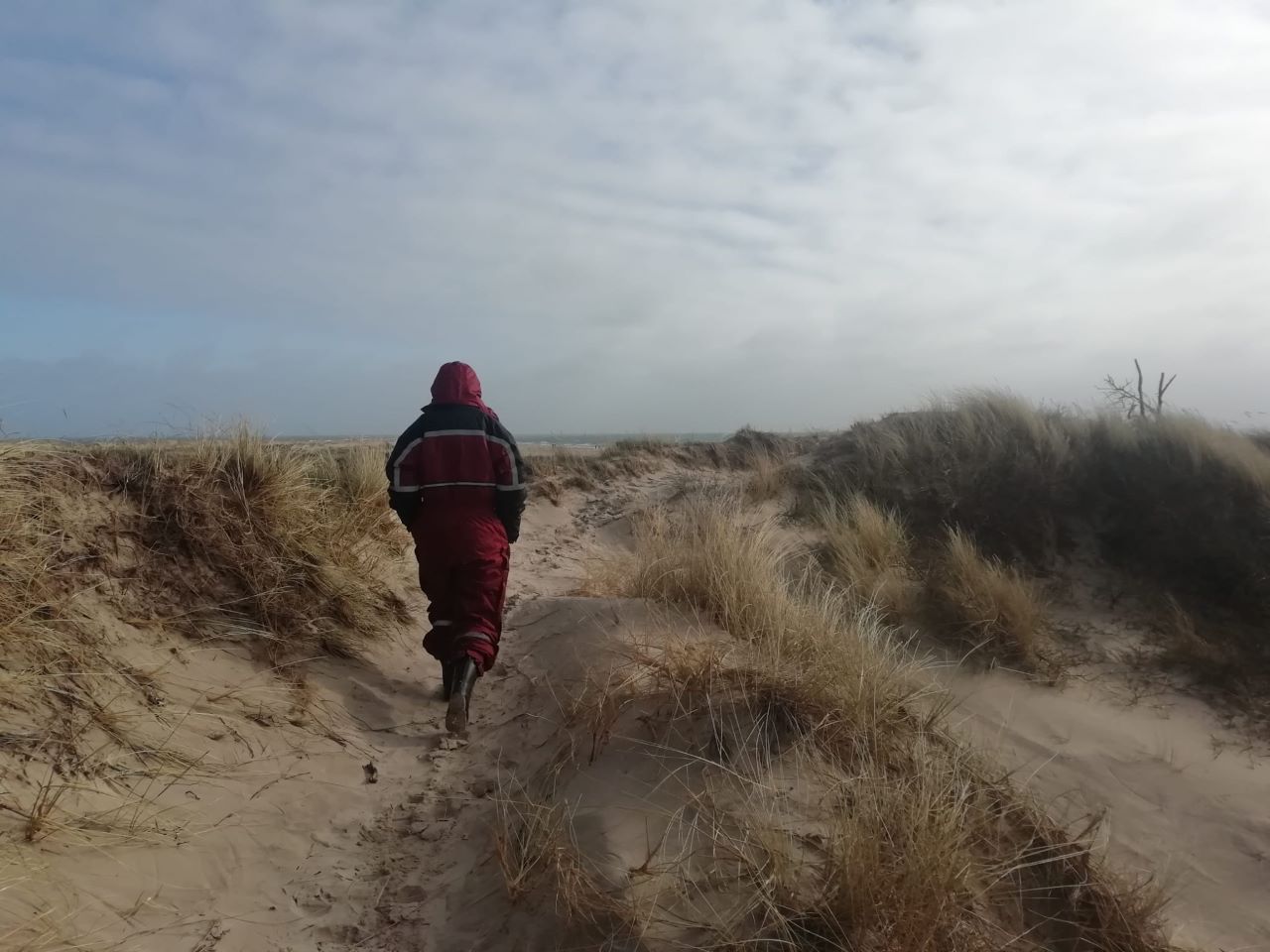
This weekend there is also the NOVANA-Seabird count for which we count the sea around Grenen and the Skarvsøn. This count concentrates on the resting birds, which were mostly Scoters (Sortand) and Eiders (Ederfugl). We are also hoping for a King Eider (Kongeederfugl) these days, but we could’t find one yet. Probably in the next weeks, we will definitely continue on checking all flocks of Eiders (Ederfugl) we see.
In the afternoon the wind got stronger and colder. After we entered the data from the day and checked some old ringing data, we spent the rest of the day in the warm living room, making some music and eating all the snacks we could find in the kitchen.
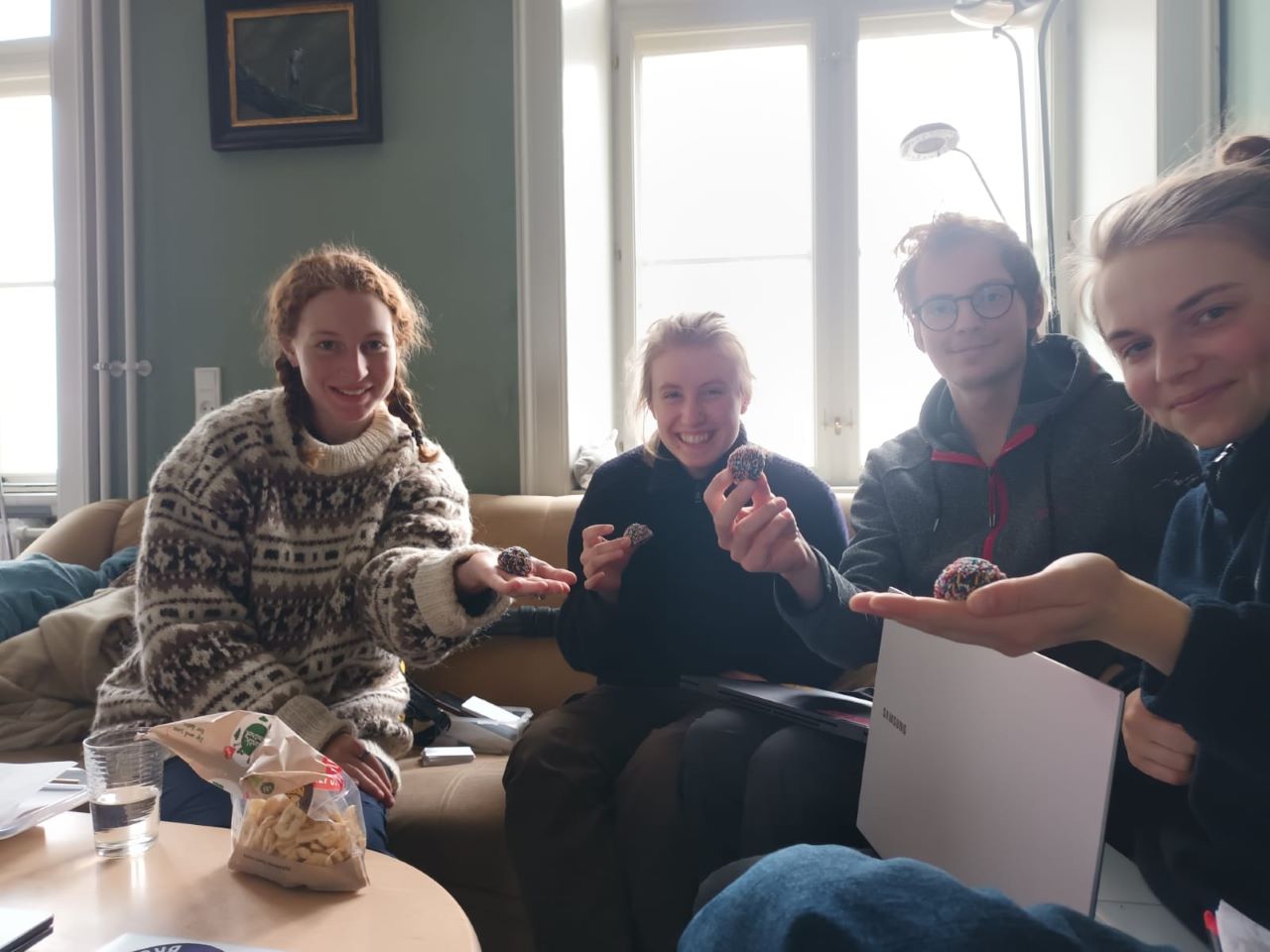
People: Johanna Veentjer, Isis Khalil, Magnus Houen Lauritsen, Simon Kiesé, Mira Kieckbusch
Today’s observations in Dofbasen from observers in the area
Sum of the Raptors in the area based on observations typed into Dofbasen the same day
Fallout… Bird Fallout
Today the fog persisted, but we decided to brave the end of the world regardless. It was significantly warmer than previous days, and with winds coming up from the south we saw an incredible increase in migration at World’s End 1 this morning. Upon departing the lighthouse we were met by hundreds of Blackbirds [Solsort]. In every bush, shrub, tree, and on every path there was a blackbird, it was a stark contrast to the barren mornings which came before. Aside from Blackbirds [Solsort] there were flocks of thousands of Jackdaws [Allike], Common Wood-Pigeons [Ringdue], Common Scoters [Sortand], Whooper Swans [Sangsvane], and so on. We also had the pleasure of seeing hundreds of Common Buzzards [Musvåge] fill the skies (including one beautiful bright white pale morph) along with a few White-Tailed Eagles [Havørn]. There was also a rumoured Golden Eagle [Kongeørn] in the area this afternoon!
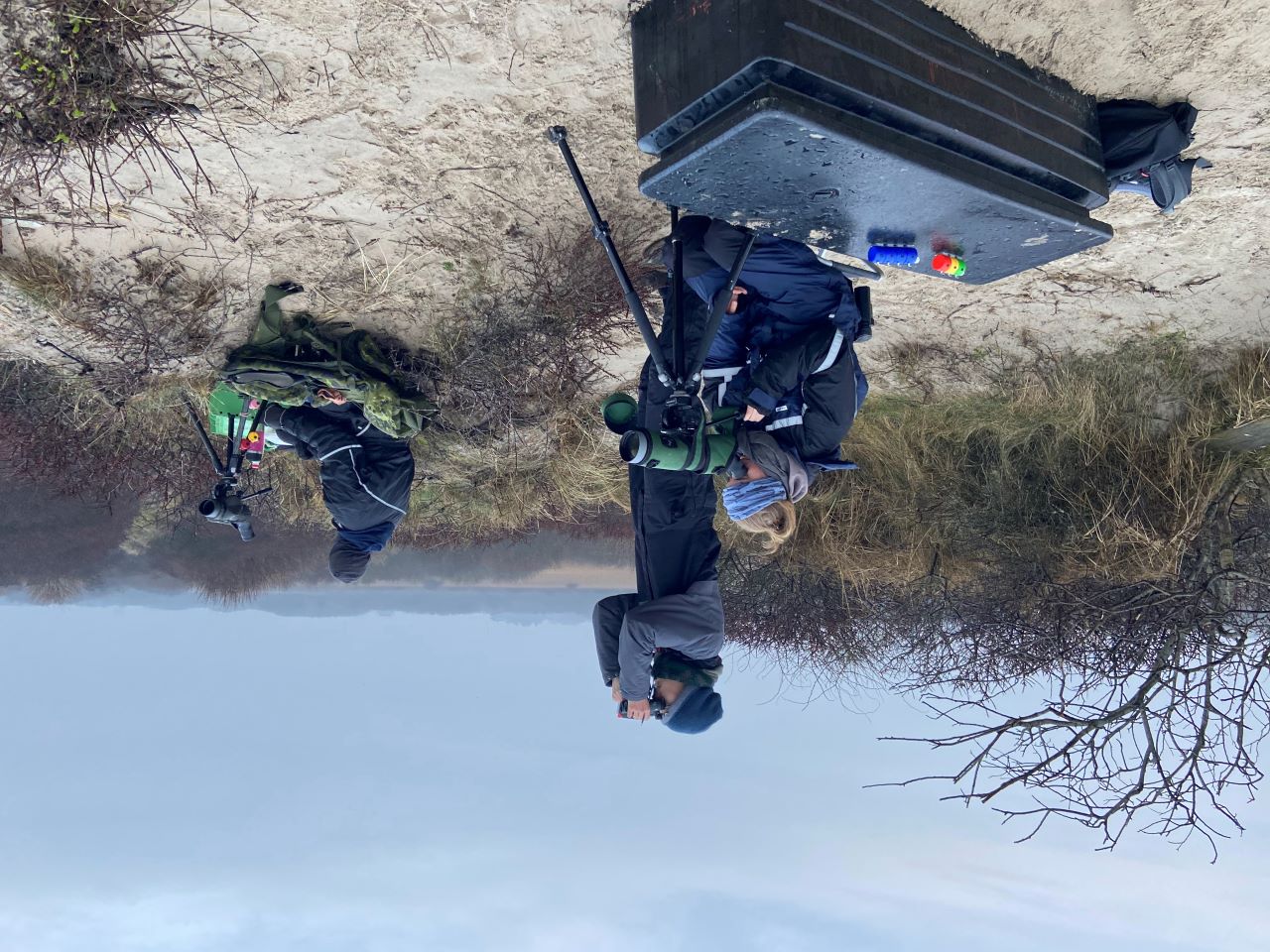
Simon and Mira at World’s End 1.
We faced a bit of wind, and some rain, but it was futile in bringing down our moods after such a successful morning. In the end, we reached nearly 90 species during this morning’s count! After Simon, Mira, and I had completed the standardized 4 hours after sunrise, Magnus and Johanna came and continued a couple more hours of counting. During their count they saw a Short-Eared Owl [Mosehornugle], this could be one of the earliest to come to Skagen! Could it be following the Blackbirds [Solsort]...?
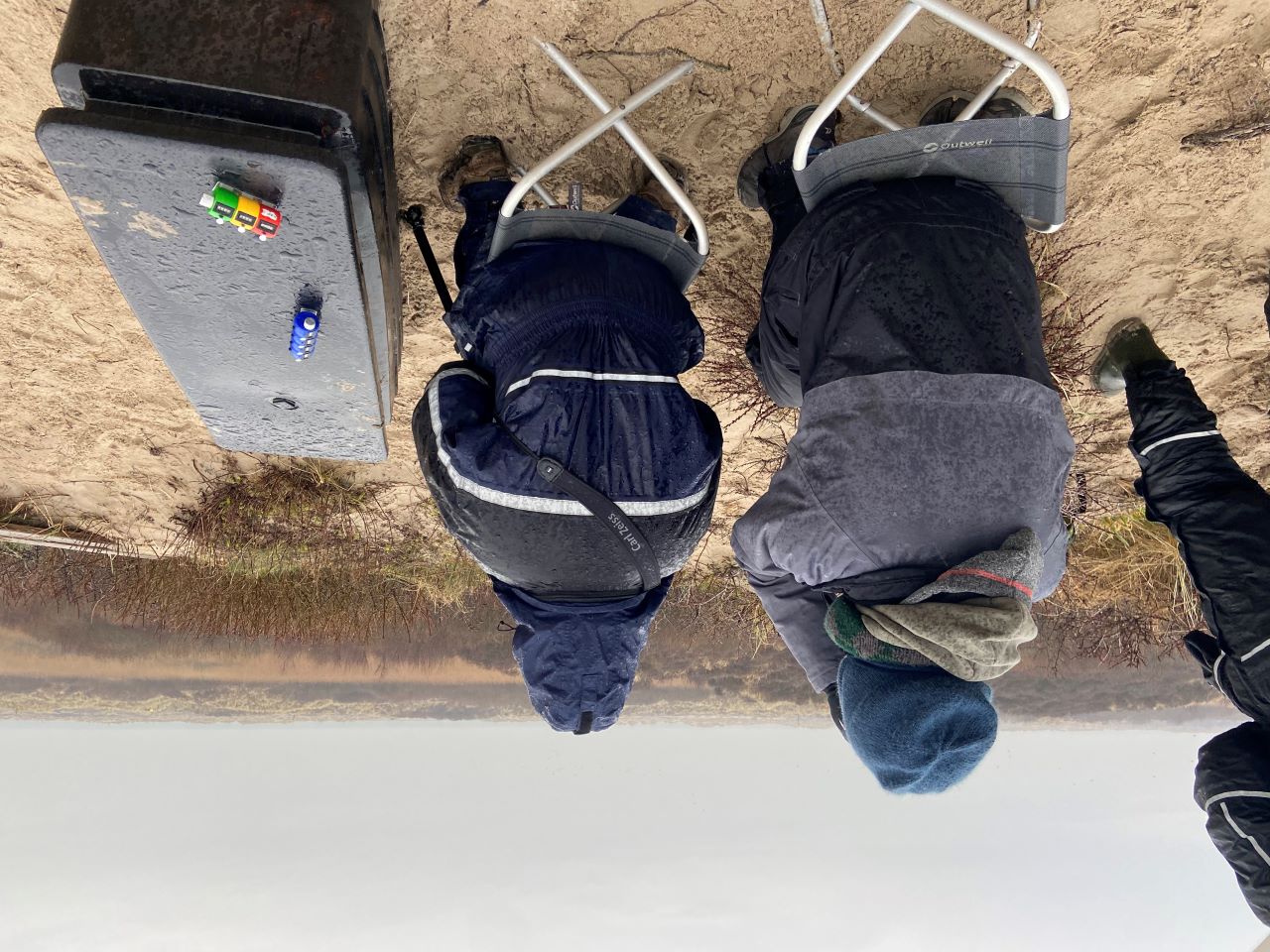
Simon and Mira in the rain at World’s End 1.
After our exciting morning, we all had a big lunch. Simon and I entered the morning counts into DOFbasen and then we headed out to Kabeltromlen to set up some more nets. We were excited to debut our beautiful waders on the runways of Skagen…
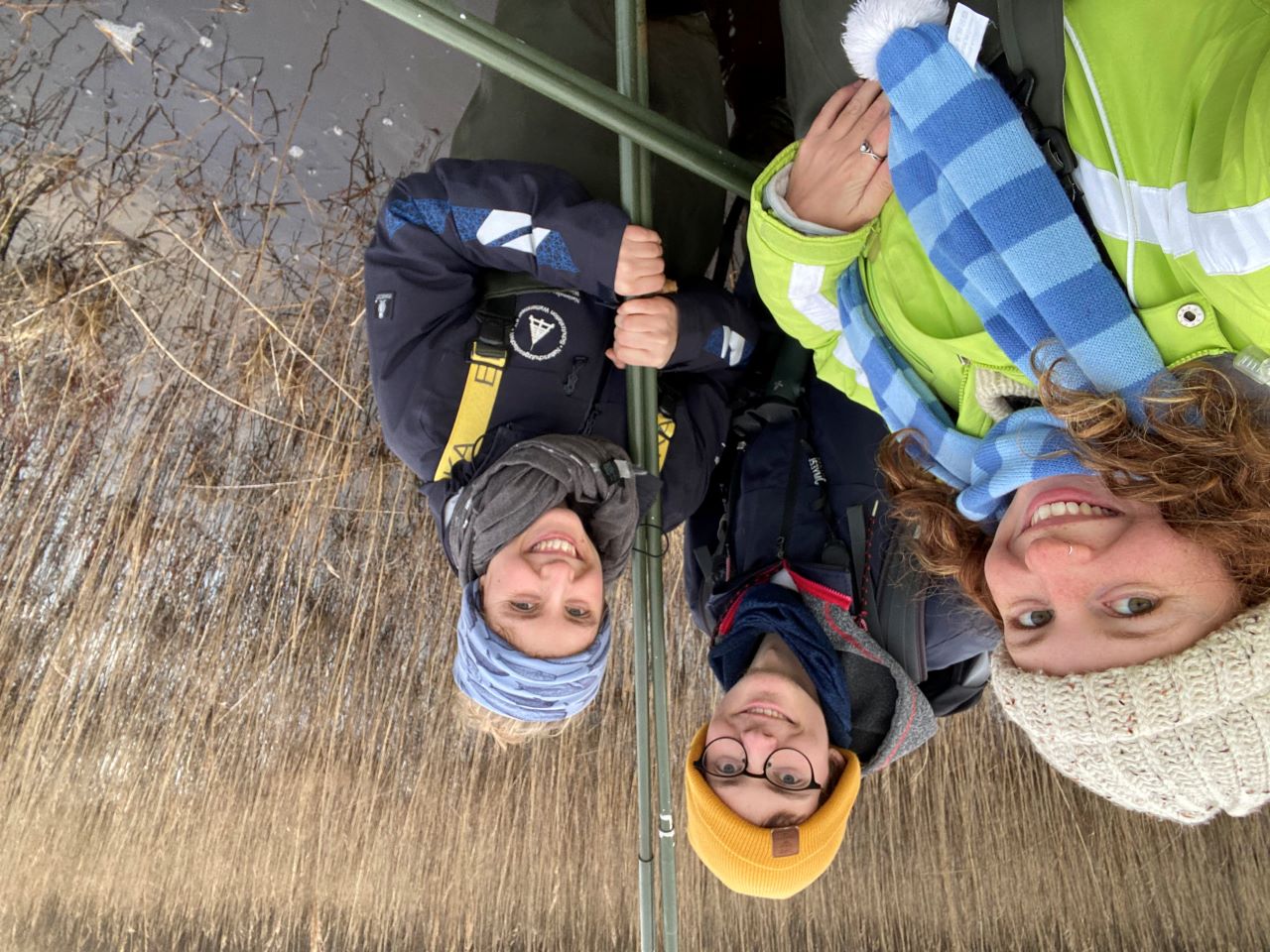
Simon, Mira, and I looking positively dashing in our wading uniform.
All jokes aside, we were all grateful to have stayed dry in our wading suits amidst the (sometimes quite deep) puddles. I do expect these puddles to get the best of me at some point before my time here is done... As for now, I triumphed over the slippery bumpy grounds beneath that murky water (not always elegantly, I admit, but my face has yet to hit the ground). Kabeltromlen Puddles: 0, Isis: 1. It was not so cold, and by the afternoon all wind and rain had subsided, leaving us with the perfect conditions to work in.
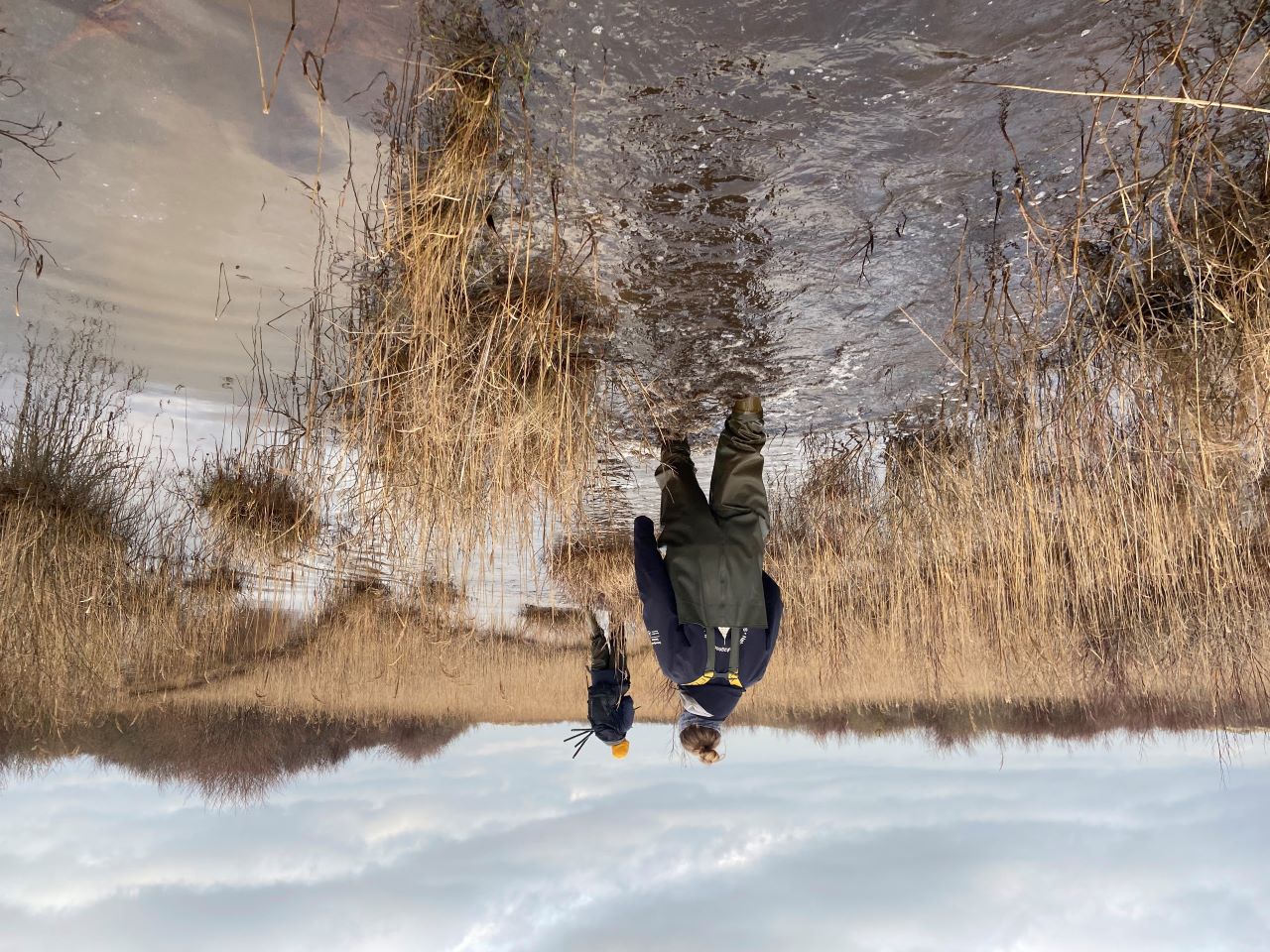
Wading through the deep waters of Kabeltromlen.
We worked productively, and right at the golden hour we noticed hundreds of Blackbirds [Solsort] flying over us. Johanna and Magnus had just arrived to bring us more supplies for the nets, and began counting immediately. From that point until the sky was nearly fully dark, they counted while we set up the remaining nets. Almost 2000 Blackbirds [Solsort] passed us by during that short period of time! This event was truly a spectacle.
I have never seen skies so full, today was a gift that kept on giving.
After our busy day, Johanna prepared some incredible Asian-style noodles for us. We ate dinner and headed to bed filled with hope and excitement for more wonderful days such as this one.
Today’s observations in Dofbasen from observers in the area.
Sum of the raptors in the area based on observations typed into Dofbasen the same day.
People: Johanna Veentjer, Mira Kieckbusch, Isis Khalil, Magnus Houen Lauritsen, Simon Kiesé
